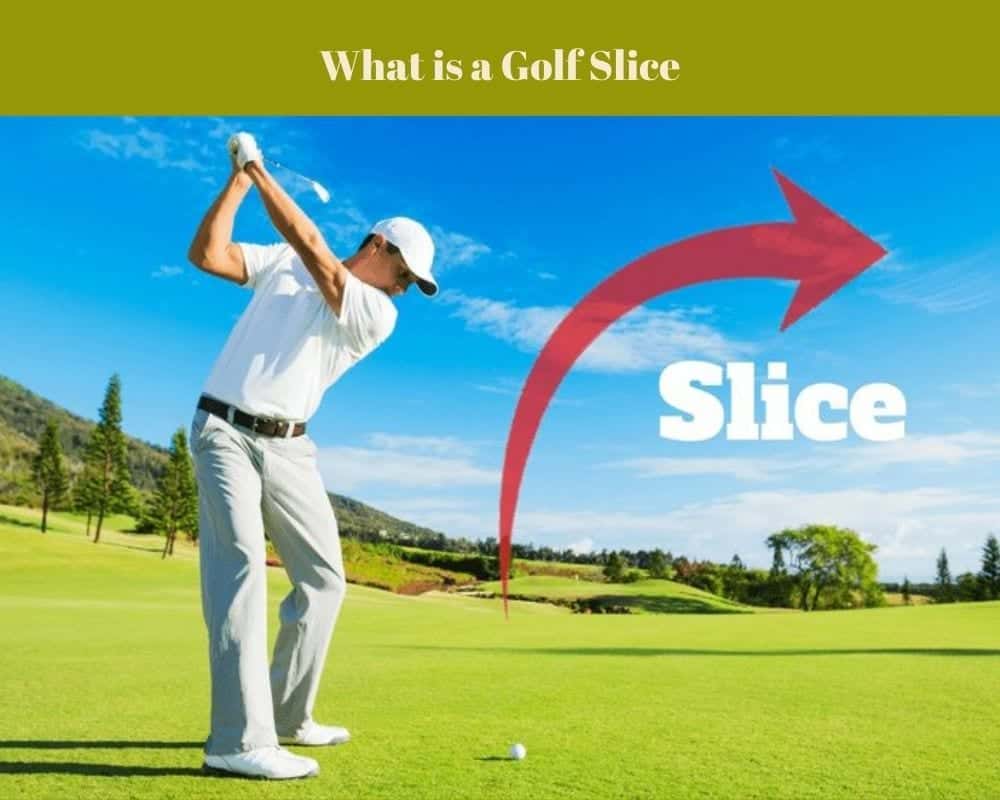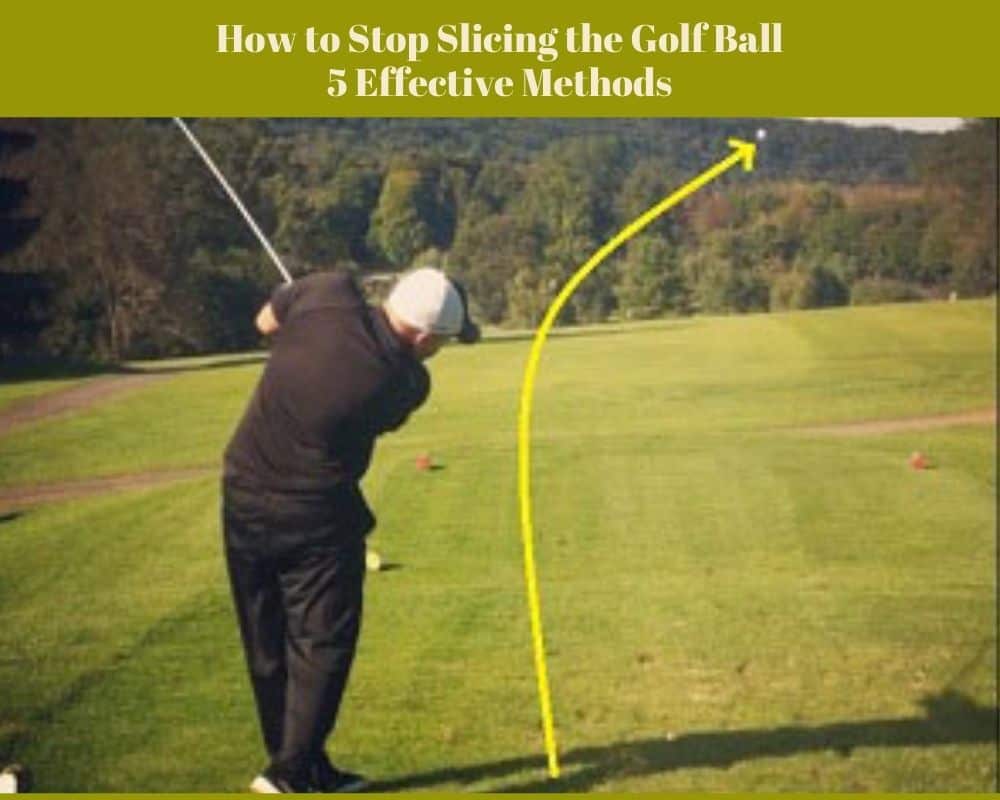The slice is one of the common and frustrating faults in golf that every golfer plays. Although it is not as destructive as the hook, it reduces the chance of getting good scores.
Except for losing good scores, there are some other good reasons why people want to know how to stop slicing the golf ball.
Slices cause you to lose temper, accuracy, and distance. If you can’t fix slicing, playing great golf would be tough. Unfortunately, 90% of golfers play slice regardless of the skill level, and the quick fix is unavailable.
Here are some tips on how to avoid slicing the ball.
What is a Golf Slice?

99% of amateur golfers play sliced golf shots.
It is known as a golf slice when a golf ball curves excessively to the right for the right-handed golfer and to the left for left-handed golfers.
However, if your ball stays right without curving after starting right, then it is not sliced. In this case, you are blocking. This is also a fault, and it happens when a golfer plays the shot by coming too far from the inside. Most of the time (though not all), this fault is the opposite of slicer.
What Causes Slice in Golf?
Well, a fault can easily be avoided if we know the root cause.
In simple words, an outside-in swing path is the most common reason for the slice. It means that, through your downswing’s initial part, your golf club is out of line with the ball (or it is further away from you).
To contact the ball, you compensate by swinging the club inside the line from outside the ball line.
Combine an open clubface with it; this is an instinct that focuses on resisting your outside swing path, and similar to a ping-pong ball, your ball will swing in the air.
How to Stop Slicing the Golf Ball – 5 Effective Methods

Now we know the definition of slice and the reason for this fault. In this section, we will look into the fixes of slicing the golf ball.
Method 01: Grip Strengthening
To be honest, this is the most common tip that everyone will advise you to stop slicing the golf ball. But, the truth is, you should really check your grip while playing a shot.
Clockwise rotating of your lead hand will help you to strengthen your grip. At the same time, it will eliminate opening the face so much on the downswing. A closed face will also be promoted when you do so.
In most cases, it will help you fix golf slices.
It would be best if you strengthen your grip following the above advice before applying all other methods.
Note: Many of us aim left before compensating our golf slice, which is not a good practice at all. A new fault will be created, which is pull hooking when you do so. I believe you won’t love to make a new fault, right?
At this point, aim at the middle or slightly aim right after strengthening your grip.
Method 02: The Clubface Closing on the Downswing
When the clubface is open on the path, a golf slice occurs. It means clubface closing will assist you in getting rid of the problem. For this, you have to rotate your hands clockwise.
In this case, most golfers close the face just after the transition. Downswing occurs with no time that you just can’t stop hitting the ball before closing the face.
Sadly, your swing gets introduced to an element of timing; experimenting is necessary.
Lately, close the face, let the ball continue to slice, quickly do it, and the ball will start to hook.
Find the sweet spot.
Note: You can simply stop slicing the golf ball by doing the opposite, which is an example. In this method, all you need to do is, enhance the closing face and let the ball start hooking; then, you will be able to stop golf ball slicing effectively.
Method 03: Choose the Right Shaft Flex
The right golf equipment plays a vital role in golf ball flight. Playing golf is quite challenging, and it can be more difficult if you choose the wrong gear.
Evaluating the shaft flex is the first thing that you will need to do. Don’t buy a shaft that comes with too much flex. Squaring the face will be much more difficult when you choose a shaft with too much flex.
We shared a short guide on the shaft selection process for your driver according to your swing speed and carry distance.
Extra Stiff (X Flex): The best option for 110 mph or higher swing and 270 yds. of driver carry distance.
Stiff Flex (S Flex): For 95-110 mph swing and 240-270 yds. driver carry distance.
Regular (R Flex): For 85-95 mph swing and 200-240 yds. driver carry distance.
Amateur & Senior (A and M Flex): For 75-85 mph swing and 180-200 yds. driver carry distance.
Ladies (L Flex): For 75 and below mph swing. Less than 180 drivers carry distance.
You will love to know that most drivers are available with adjustable settings of the clubface. If the tool is available with your driver, set it to draw-biased or neutral settings. The final thing that you want is a faded promotion in your clubface setup.
Method 04: Weight Transferring
Although weight transferring is a simple concept when golf swing, unfortunately, many golfers don’t do it properly.
According to the golf’s basic level, when swinging back, our bodyweight moves more towards our back foot. Next, when we start the downswing and making a shot, our weight comes back to our front foot.
Most amateur players do the vice versa at this point. Their weight moves towards the back foot when they backswing and releases the weight through the follow-through & down-swing.
As a result, it opens the clubface that leads them to slice the golf ball.
So, it is significantly essential that you should learn about transferring your weight in the golf swing.
Practicing this is so simple. First, place any object that reaches your thigh in front of your front foot—then your left thigh gets touched at the time of your setup.
When making a shot, if you see that your thigh is slightly moving away from the object, it indicates that your weight is transferring towards your rear foot.
Therefore, you start your downswing; if your weight is transferred correctly in your thigh, the object will come into contact with your thigh.
Once you transfer your weight to the back foot, there will be a gap between your thigh and the object.
This way, you will see that your ball is not excessively swinging on the left or right side.
Method 05: Avoid Aiming for a Golf Slice
Slicing the golf ball will be inevitable when you play left to right wind. Moreover, the situation can worsen if the wind is coming from the left. Thus, the ball will go nowhere. Also, the golf ball will slice this way.
Don’t aim more left as it will stop your progress. Instead, what happens is that you swing further from the target’s left to right. As a result, the face gets more open.
When you learn to lengthen your face, your swing path improvement will only work then.
So, the most important thing is, you need to practice a lot to open the stance slightly. Next, correct weight shifting is necessary and turning the body through impact.
Frequently Asked Question (FAQ)
Does a strong grip eliminate the slice?
Yes, a strong grip eliminates a slice. You can take 1 or 2 sessions from a Pro player to improve your grip. Remember, practicing a strong grip will let you eliminate that nasty golf slice.
Can a bad grip cause a slice?
When you grip a club badly, your thumbs will be on top of the club. So, after the swing, the clubface will open and you will hit a slice.
What happens if the golf grip is too strong?
Too strong golf grip is also not good at all. you will wind up in a shut position at impact and the ball will quickly curve to the left.
Can standing too close to the golf ball cause a slice?
In fact, a golf slice may also happen if you stand too close to the golf ball. Loss of balance and speed, change in swing path, low hooks, toe hits will also occur.
Summing Up
Solving how to stop slicing the golf ball would never be possible if you don’t know the reason behind it.
Undoubtedly, you need to mandatorily follow the above tips and tricks to stop slicing golf balls. If you cannot stop it, no matter what, your progress will stop whatever you do.
Now, you know the rules. It’s time to hit the range.
Related Posts:
How to correct a slice with your driver
